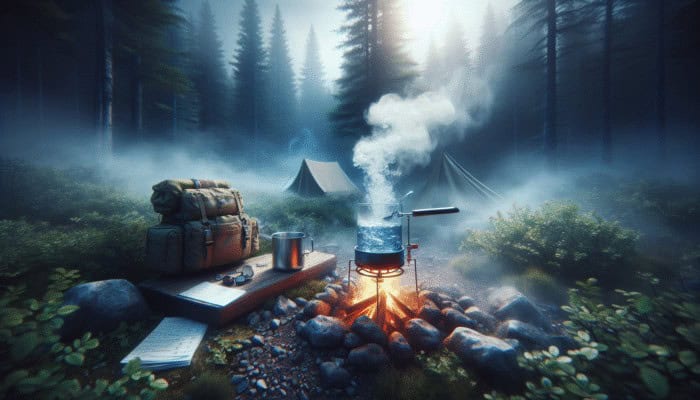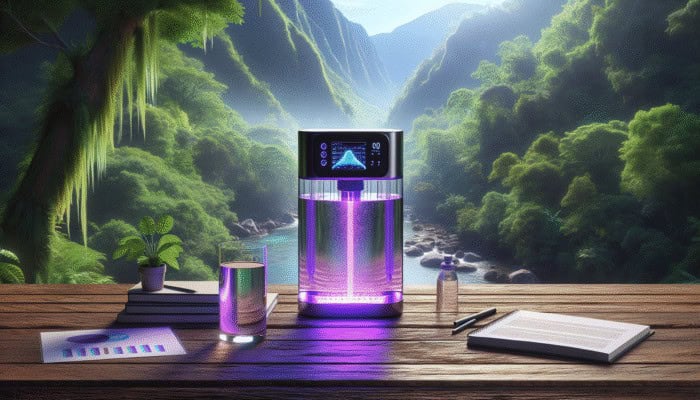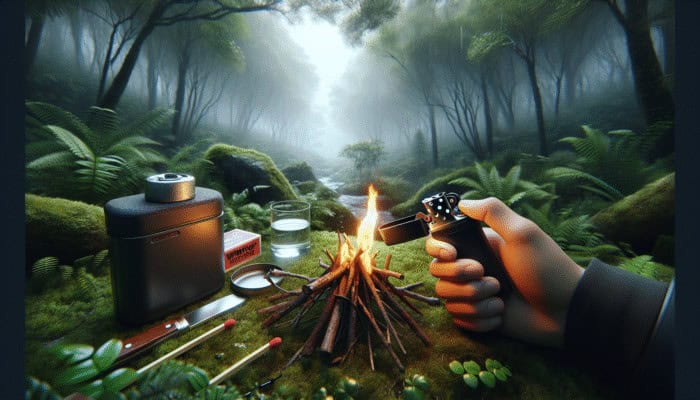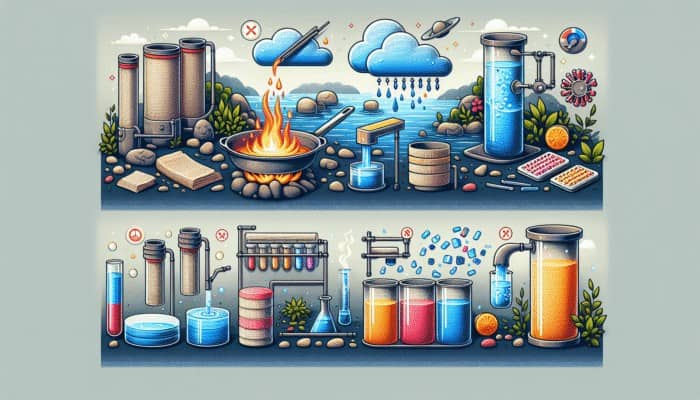Comprehensive Water Purification Strategies: Your Essential Guide to Safe Drinking Water
Essential Survival Tools: Having access to clean drinking water is vital for survival, particularly in emergency scenarios where the risk of contamination is high. Consuming impure water can lead to serious health issues, including gastrointestinal infections and other diseases. By familiarizing yourself with various water purification methods, you can ensure access to safe drinking water in diverse environments, whether you find yourself in the wilderness, lost during a hike, or in areas lacking proper infrastructure. Understanding these methods not only empowers you but also enhances your confidence in handling unexpected situations effectively.
Harnessing Boiling Water for Effective Purification

Boiling water is widely recognised as one of the most reliable and effective methods for purifying water. By heating the water until it reaches a rolling boil for at least one minute (or three minutes if you are at high altitude), you can eliminate harmful pathogens, including bacteria, viruses, and parasites. This purification method is universally applicable and requires only a heat source and a container, making it accessible to anyone. Whether you use a campfire, a portable stove, or even a solar cooker, boiling water is a straightforward yet powerful tool in your survival toolkit.
In survival situations, the ability to boil water can truly make a significant difference. For example, when hiking through remote areas, natural water sources like lakes or streams might appear crystal clear but can still harbour hidden pathogens. Boiling the water guarantees its safety for consumption, and this can be accomplished even under the most basic conditions. Therefore, it is crucial to have a dependable means of igniting a fire or a compact burner to utilise this essential method of water purification effectively.
Moreover, even during urban emergencies where the water supply might be compromised due to contamination, boiling can provide invaluable peace of mind. However, it’s essential to remember that boiling water does not remove chemical pollutants or heavy metals, which can also be harmful. Therefore, it is advisable to combine boiling with other purification techniques to achieve comprehensive water treatment for complete safety.
Efficient Chemical Purification Techniques
Chemical purification methods involve utilising substances such as iodine or chlorine tablets to disinfect water quickly. These chemicals are highly effective at eliminating harmful microorganisms, making them a practical choice for those venturing into regions without reliable water sources. Iodine tablets, in particular, are especially useful due to their compact size and extended shelf life, making them a convenient addition to your survival kit.
To purify water using chemicals, dissolve the recommended number of tablets in a specific volume of water and allow it to sit for the prescribed duration before consumption. This method proves advantageous during emergencies, where you may not have the luxury of time to wait for boiling. However, precise measurement and adherence to guidelines are essential for the effectiveness of this method.
While both iodine and chlorine are adequate, they may impart an unpleasant taste to the water. To improve the drinking experience, consider adding a splash of fruit juice or using flavour packets. Additionally, individuals with thyroid issues or pregnant women should consult healthcare professionals before using iodine. For long-term survival scenarios, it’s prudent to familiarise yourself with all available chemical purification options and understand their implications for health and safety.
Portable Filtration Systems: Your Essential Survival Companion
Portable water filters are invaluable, essential survival tools that allow you to obtain clean water from natural sources. They come in various designs, ranging from simple straw filters to advanced pump systems capable of removing bacteria, protozoa, and even some viruses. The importance of having a reliable filtration system cannot be overstated, particularly for those planning to spend extended periods in the wilderness or remote locations where clean water is scarce.
When selecting a filtration system, consider factors such as portability, flow rate, and the specific types of contaminants it can remove. Some advanced filters are designed to eliminate viruses, while others may only target bacteria and protozoa. It’s crucial to read product specifications carefully and choose a filter that meets your specific needs. For instance, lightweight filters are ideal for backpackers, while larger systems might be more suitable for groups or families.
Using a filtration system is typically straightforward, but it does require regular maintenance. To ensure optimal performance, clean the filter according to the manufacturer’s instructions. Furthermore, it’s essential to note that filters can become clogged over time. Therefore, having a backup purification method, such as boiling or chemical treatment, is advisable, especially in emergencies where access to clean water is critical.
Ultraviolet (UV) Purification: A High-Tech Solution

Ultraviolet (UV) purification is an innovative method that utilizes UV light to eradicate pathogens in water effectively. This technology has gained popularity for its effectiveness and ease of use. By exposing water to UV light for a short duration, you can successfully eliminate bacteria and viruses without relying on chemical agents, making it an attractive option for many outdoor enthusiasts.
Portable UV purifiers are compact and battery-operated, rendering them ideal for travellers and adventurers on the go. To utilise this method, fill a clean container with water, insert the UV device, and activate it. Within just a few minutes, you’ll have purified water ready for consumption. This method is particularly valuable in areas where boiling is impractical or where chemical treatments are not desired.
However, UV purification does have certain limitations. It is ineffective in turbid or cloudy water since impurities can shield microorganisms from UV light, making pre-filtering necessary in such cases. Additionally, as UV devices require power, ensuring you have spare batteries or a solar charger can enhance reliability during extended outings in remote areas.
Solar Disinfection (SODIS): Harnessing Nature’s Power
Solar Disinfection (SODIS) is a clever method that utilises sunlight to purify water. By filling clear plastic bottles with water and exposing them to direct sunlight for a minimum of six hours, harmful microorganisms can be effectively neutralised. This method is straightforward and highly accessible, particularly in sunny regions where natural sunlight is abundant.
SODIS is an excellent option for crises or remote areas where other purification methods may not be available. It requires minimal resources—just clear bottles and sunlight—making it a practical choice for many. While this method is primarily effective against bacteria and viruses, it may not eliminate chemical contaminants. Therefore, consider combining SODIS with another purification method if you suspect chemical pollution in your water source.
The beauty of SODIS lies in its cost-effectiveness and sustainability. It requires no special equipment beyond commonly available clear plastic bottles, making it an invaluable tool for communities struggling with access to clean water. By embracing SODIS, you contribute to environmental awareness and responsible water management practices, fostering a sense of community and self-sufficiency.
Mastering Fire Starting Techniques: Your Essential Guide to Warmth and Cooking
Fire is a fundamental element of survival, providing warmth, protection, and a means to prepare food. Mastering various fire-starting techniques not only enhances your ability to thrive in unpredictable conditions but also fosters confidence in your survival skills. From simple matches to intricate friction methods, understanding these techniques can significantly impact your survival experience.
Simple Yet Effective: Using Matches and Lighters

The most straightforward way to start a fire is by using matches or lighters, which are essential components of any survival toolkit. They are compact, easy to use, and require minimal effort to ignite. Waterproof matches and windproof lighters are especially beneficial for outdoor survival as they remain functional in adverse weather conditions, ensuring that you can start a fire when it matters most.
When preparing for your outdoor journey, it’s crucial to pack multiple fire-starting options, including a reliable lighter and a pack of waterproof matches. Storing these items in a waterproof container can help prevent moisture from affecting their effectiveness. Practising the use of these tools in various conditions will build your confidence and familiarity, ensuring you are well-prepared for any situation.
While matches and lighters are excellent for quick ignition, achieving a sustainable fire requires proper technique. Gather tinder, kindling, and fuel wood in advance, arranging them in a manner that allows for optimal airflow. Knowing how to build and maintain a fire efficiently will enhance your ability to utilise these essential tools effectively in survival scenarios.
Flint and Steel: A Reliable Method
Using flint and steel provides a dependable method for starting fires, eliminating the need for modern conveniences. This ancient technique involves striking steel against flint to generate sparks that ignite tinder. While mastering this skill requires practice, it can be achieved with patience and repetition.
Investing in a quality flint and steel kit can offer a long-lasting solution for fire starting. Many kits come with additional components, such as magnesium shavings, to enhance ignitability. When employing this method, gather dry tinder such as dry grass, leaves, or cotton balls to catch the sparks and create a flame effectively.
The beauty of flint and steel lies in its independence from fuel sources, making it a sustainable choice for fire-starting. If you’re camping or hiking, practice this technique to build muscle memory, ensuring you’re prepared to create a fire when you need it most. Additionally, combining flint and steel with other fire-starting methods can result in a versatile and effective strategy for igniting flames.
Friction Fire Starting: An Impressive Skill
Mastering the art of friction fire starting is an impressive skill that connects you with primitive survival techniques. This method relies on generating heat through friction, typically using tools such as a bow drill or hand drill. Although it is more challenging than other techniques, the satisfaction of creating fire by hand is unparalleled and can be a rewarding experience.
The bow drill method involves a bow, a spindle, a hearth board, and a fireboard. By moving the spindle back and forth in the hearth, you generate heat that produces an ember. This ember can then be transferred to tinder to ignite a fire. Mastery of this technique requires practice and an understanding of the right materials, including specific wood types that yield optimal friction.
Learning how to start a fire with friction not only enhances your survival skills but also deepens your appreciation for traditional survival methods. Practice in different environments and conditions, as the ease of creating friction can vary with humidity and wood types. Preparing your tinder and kindling ahead of time will significantly increase your chances of success when you finally achieve that first spark.
Utilising Chemical Fire Starters
Chemical fire starters, such as fire starter cubes or gels, offer a quick and effective means of igniting fires in challenging conditions. These products are specifically designed to ignite easily and burn for extended durations, overcoming the difficulties posed by damp or windy environments.
Many chemical fire starters are compact and lightweight, making them a popular choice among outdoor enthusiasts. When using chemical starters, always follow the manufacturer’s instructions for safety and efficiency. Furthermore, ensure you are in a well-ventilated area to avoid inhaling harmful fumes that may be released during ignition.
While chemical fire starters are highly effective, they should be integrated into a broader fire-starting strategy. Knowing how to build a fire using natural materials and traditional techniques will enhance your survival chances during emergencies. Keeping a few chemical starters in your kit as a backup ensures you are well-prepared for unexpected challenges while camping or hiking.
Solar Fire Starting: A Sustainable Technique
Harnessing the power of the sun through solar fire starting can be a thrilling and effective way to ignite a fire. By using tools like magnifying glasses or parabolic mirrors, you can focus sunlight onto tinder to create a flame. This method requires patience and the right conditions, specifically clear skies and direct sunlight, but can be incredibly rewarding.
To use a magnifying glass, position it between the sun and your tinder, adjusting the distance until you see a concentrated beam of light. This method can ignite dry grass, leaves, or paper within seconds, making it a valuable technique to master. It’s crucial to practice this skill and understand the ideal conditions that maximise your chances of success.
While solar fire starting can be immensely rewarding, it does have limitations. Cloudy weather or insufficient sunlight can hinder your efforts, so it’s essential to have alternative fire-starting methods readily available. Embracing this eco-friendly technique can enhance your survival toolkit, providing a sustainable option for igniting fires while minimizing your environmental impact.
Fundamentals of Shelter Building: Your Essential Guide to Protection Against the Elements
In survival situations, constructing an effective shelter is critical for protection against environmental elements. Whether you are facing harsh winds, rain, or extreme temperatures, understanding the fundamentals of shelter building can significantly improve your chances of survival. With the right knowledge and tools, you can create a shelter that provides both safety and comfort in even the most challenging conditions.
Maximising Versatility with Tarp Shelters
Tarps are incredibly versatile and lightweight essential survival tools for constructing temporary shelters in the wild. They can be set up quickly, providing immediate protection from rain, sun, and wind. Available in various sizes and colours, tarps can be adapted to fit different environments and specific needs.
To create a tarp shelter, locate two sturdy anchor points, such as trees or large rocks, that can support the weight of the tarp. Using rope or paracord, suspend the tarp in a sloping position to allow rainwater to run off effectively. This setup not only shields you from the elements but also creates a shaded area during hot weather, enhancing your comfort.
One significant advantage of tarp shelters is their adaptability. You can configure them in numerous ways depending on weather conditions and the materials available. Learning basic knots can improve your ability to secure the tarp effectively. Additionally, incorporating natural materials like leaves or branches can provide extra insulation and camouflage, allowing your shelter to blend seamlessly into its surroundings.
Building Debris Huts: A Time-Honoured Technique
Constructing a debris hut is a time-honoured technique that utilises natural materials to create an insulated shelter. This method is particularly effective in forested areas where an abundance of leaves, branches, and organic materials is available. The structure relies on a framework of sticks covered with layers of debris, providing excellent insulation against cold weather.
To build a debris hut, begin by creating a sturdy framework using long branches to form a cone shape. Once the basic structure is established, cover it with leaves, pine needles, or grass, ensuring that there is enough insulation material. The more debris you can gather, the warmer your shelter will be. Be sure to leave an entrance that is easy to crawl into, ensuring you have a comfortable resting space within.
Debris huts are ideal for emergencies, offering warmth and concealment. However, it’s essential to keep your hut dry and free from potential sources of moisture. Regularly check for gaps or leaks in the covering and reinforce them as needed to maintain an effective barrier against the elements, ensuring you remain comfortable and protected.
Constructing Snow Caves: A Warm Refuge in Winter
In snowy conditions, building a snow cave can provide a warm and safe shelter. Snow has excellent insulating properties, allowing it to retain heat effectively. Constructing a snow cave involves digging into a snowbank to create a hollow space that protects you from harsh winter elements, making it a vital skill for survival in cold environments.
When selecting a site for your snow cave, look for a stable snowpack and avoid areas with potential avalanche risks. The entrance should be kept low to the ground to minimise heat loss and provide easy access. After excavating the cave, ensure that there is adequate ventilation to prevent the buildup of carbon dioxide, which can be hazardous in enclosed spaces.
Snow caves can surprisingly stay warm, with internal temperatures remaining significantly higher than those outside. It’s beneficial to insulate the walls with additional snow and create a bed of insulating materials, such as extra clothing or gear, to enhance comfort. Knowing how to build a snow cave can be a lifesaving skill in snowy environments, allowing you to shelter from the cold and conserve energy effectively.
Essential Navigation Skills: Your Guide to Finding Your Way
Navigating through unfamiliar terrain can be daunting, yet mastering navigation skills is vital for survival. Whether you are trekking through dense forests or crossing vast deserts, the ability to orient yourself can mean the difference between safety and danger. Familiarity with various navigation tools and techniques empowers you to explore with confidence, ensuring you can find your way even in challenging conditions.
Mastering Map and Compass Navigation
Using a map and compass is fundamental for accurate navigation in the wilderness. These tools provide a reliable means to pinpoint your location and chart a course to your desired destination. Learning to read a map and understand compass bearings can significantly enhance your navigation skills, making it easier to traverse unfamiliar landscapes.
To effectively use a map and compass, start by orienting the map to align with your surroundings. Identify prominent landmarks and plot your intended route. The compass will guide you in determining which direction to head, and understanding declination—the angle between true north and magnetic north—is crucial for accurate navigation in various terrains.
Practising this skill in different environments will build confidence and familiarity with the tools. Always carry a physical map in addition to digital tools, as technology can fail at critical moments. Being adept at map and compass navigation ensures you can traverse even the most challenging terrains safely, increasing your chances of survival in unfamiliar areas.
Celestial Navigation: Guiding Your Way by the Stars
When traditional navigation tools are unavailable, celestial navigation can provide invaluable guidance using the stars and the sun. This ancient technique relies on observing celestial bodies to determine your position, making it a rewarding skill for adventurous travellers and outdoor enthusiasts.
During the day, you can use the sun’s position to determine direction. The sun rises in the east and sets in the west, providing a general orientation. At night, constellations such as the North Star (Polaris) serve as reliable navigational aids for those in the Northern Hemisphere. Familiarizing yourself with key constellations and their movements enhances your ability to navigate effectively, even when other tools are unavailable.
Celestial navigation requires practice and a clear understanding of how to read the night sky. When travelling to different hemispheres, take time to familiarise yourself with the celestial bodies unique to those regions. This skill can be invaluable for adventurers and explorers, providing a natural sense of direction when technology fails to function.
Leveraging Landmarks and Terrain for Navigation
Recognising natural landmarks and understanding terrain features is an essential navigation skill that can guide you through unfamiliar areas. Intuitive observation of your surroundings can provide clues about your direction and help minimise the risk of getting lost.
Familiarise yourself with prominent landmarks such as mountains, rivers, and valleys, which can serve as reference points during your journey. Understanding the lay of the land—whether you’re navigating through a dense forest, rocky terrain, or along a coastline—can provide insights into your navigation strategy. Additionally, observing the terrain can help you identify potential hazards and safe paths to follow.
Engaging in outdoor activities, such as hiking or camping, can enhance your ability to read and interpret natural landscapes effectively. The more time you spend in various environments, the better your navigation skills will become. By embracing the natural world, you foster a deeper connection to your surroundings and enhance your ability to navigate using natural indicators effectively.
Food Procurement Strategies: Essential Tools for Sustenance
In survival situations, securing a reliable source of food is crucial for maintaining energy and health. Understanding various food procurement methods ensures you can sustain yourself in challenging environments. From foraging to fishing, mastering these techniques empowers you to thrive in the wild and enhances your overall survival capabilities.
Foraging for Edible Plants and Fungi
Identifying and collecting edible plants, berries, and fungi can significantly supplement your food supply during a survival scenario. Foraging is an essential skill that allows you to tap into the natural resources around you, providing nourishment without relying solely on stored food supplies.
Familiarity with local flora is essential for successful foraging. Research regional plants and their edibility before embarking on your journey. Always remember the adage, “When in doubt, don’t eat it.” Some plants can be toxic or harmful, so it’s essential to know which ones are safe to consume and how to prepare them properly.
Foraging also presents an opportunity to connect with nature and learn about the ecosystems around you. Engaging in foraging courses or workshops can build your confidence and knowledge about local edible species. By honing your foraging skills, you equip yourself with a valuable tool for survival and self-sufficiency, thereby enhancing your ability to thrive in the wild.
Essential Fishing Techniques for Survival
Mastering basic fishing skills can provide a reliable source of protein in survival situations. Knowing how to catch fish using various techniques can significantly enhance your food procurement strategy, especially when near rivers, lakes, or coastal areas.
Fishing can be accomplished using various methods, including rod and reel, nets, or simple handlines. Understanding local fish species, their habits, and the optimal times to fish can significantly enhance your chances of success. When fishing in freshwater, be mindful of local regulations and ensure you are aware of any potential toxins in the water that could affect your catch.
Additionally, practising catch-and-release techniques can help sustain fish populations, ensuring that you’re responsibly benefiting from natural resources. Engaging with local fishing communities or taking courses can enhance your skills and confidence in the water, making you a more effective angler in survival situations.
Trapping and Snaring for Sustainable Food Sources
Setting traps and snares is a valuable skill that can help capture small game for food and other purposes. These methods require knowledge of animal behaviour and an understanding of how to construct effective traps. Mastering these techniques can significantly enhance your chances of securing a sustainable food source in the wild, enabling you to maintain your energy levels and overall health.
Trapping can be done using various materials such as wire, rope, or natural branches. It’s essential to familiarise yourself with local wildlife and their habits to create successful traps. Constructing a variety of traps, such as deadfalls, snares, or pitfall traps, allows for flexibility in different environments and increases your odds of a successful catch.
Ethical considerations are paramount when trapping. Always ensure you adhere to local guidelines regarding trapping and hunting. Engaging in responsible practices helps maintain ecosystems and promotes the sustainable use of wildlife resources. By honing your trapping and snaring skills, you enhance your survival toolkit and increase your chances of securing food in challenging environments.
First Aid Essentials: Your Guide to Health and Safety
In emergencies, having first aid essentials readily available can mean the difference between life and death. Understanding basic first aid procedures equips you to handle injuries or medical emergencies effectively. A well-stocked first aid kit and knowledge of key medical techniques significantly enhance your survival capabilities, ensuring you can respond appropriately in critical situations.
Effective Wound Care Techniques
Properly cleaning and dressing wounds is critical for preventing infection and promoting healing. Knowing how to assess and treat various injuries can significantly enhance your first aid skills and improve outcomes in emergencies. Begin by washing your hands or using hand sanitiser before touching the wound to minimise the risk of contamination.
Using sterile gauze or bandages, gently clean the wound with clean water and mild soap. If available, apply an antiseptic solution and cover the wound with a sterile bandage to protect it from dirt and bacteria. Understanding when to seek professional medical help for severe wounds or signs of infection is also essential for effective wound management.
In remote survival situations, improvisation may be necessary. Familiarise yourself with alternative wound care techniques, such as using clean cloths or natural antiseptics like honey or aloe vera, which can aid in the healing process. Regularly assess your first aid skills and supplies to ensure you’re prepared for emergencies, making sure your kit is always stocked with essential items.
Carrying Basic Medications for Emergencies
Carrying essential medications in your first aid kit can prove lifesaving in emergencies. Common medications include pain relievers, antihistamines, and antibiotics. Understanding how to use these medications effectively is crucial for managing pain and treating minor ailments, allowing you to address health issues promptly.
Before embarking on your journey, consult with a healthcare professional to discuss necessary medications based on your specific health needs. Organise your medications in a waterproof container within your first aid kit to ensure they remain safe and accessible throughout your adventures.
Additionally, educate yourself about potential side effects and interactions for any medications you take. Familiarity with these medications can empower you to make informed decisions during emergencies, enhancing your ability to respond effectively to health issues that may arise.
Improvising Medical Tools from Available Resources
Knowing how to create medical tools from available materials can be crucial in emergencies. In wilderness survival situations, you may lack access to traditional medical supplies, so improvisation becomes essential. Familiarise yourself with common items that can serve medical purposes, such as using clean cloths for bandages or sticks for splints.
When faced with a medical emergency, assess your surroundings for resources you can utilise. For instance, duct tape can effectively secure bandages or create splints, while plastic bottles can be transformed into makeshift ice packs or water containers. Understanding how to improvise medical tools enhances your versatility in addressing health concerns in challenging situations, ensuring you are prepared for a variety of emergencies.
Always prioritise safety and hygiene when improvising medical tools. Ensure that any items used for medical purposes are clean and safe to prevent further complications. Regularly practising these skills can build confidence and ensure you’re prepared for unexpected medical emergencies during your outdoor adventures.
Essential Emergency Response Techniques
Learning basic CPR and first aid procedures can significantly improve outcomes in emergencies. Familiarising yourself with these techniques provides the confidence to act quickly and decisively when someone is injured or unresponsive, potentially saving lives.
Consider enrolling in first aid and CPR courses offered by organisations like the Red Cross or local community centres. These courses provide hands-on experience and knowledge about recognising and responding to various medical emergencies. Additionally, many courses offer certifications that enhance your credibility and preparedness in emergencies.
Understanding the signs of shock, heart attacks, or strokes can also aid in effective emergency response. Being able to assess a situation and recognise symptoms can make a world of difference in urgent scenarios. Practice your skills regularly, and ensure that your first aid kit is well-stocked and up to date, ready for any situation that may arise during your outdoor activities.
Effective Signalling for Help: Essential Tools for Rescue
When lost or in distress, signalling for help is crucial for survival. The ability to effectively communicate your location can expedite rescue efforts, enhancing your chances of being found. Understanding various signalling techniques allows you to attract attention and increase your likelihood of rescue in emergencies.
Utilising Whistles and Mirrors for Effective Signalling
Using whistles and signal mirrors is an effective method for alerting rescuers to your location from a distance. Whistles are lightweight and capable of producing sound that travels far, making them an essential addition to your survival kit. A few sharp blasts of a whistle can attract attention without depleting your energy reserves, which is critical in survival situations.
Signal mirrors, on the other hand, utilise sunlight to reflect light towards potential rescuers. By learning how to use a mirror effectively, you can create a bright signal that can be seen from a great distance. Practicing aiming the light at a target can enhance your skills, ensuring you can effectively signal for help when needed.
Incorporating both tools into your survival strategy provides you with multiple means to signal for assistance. In wilderness scenarios, where cell phones may be ineffective, these simple yet powerful tools can be lifesaving. Always keep your whistle and mirror accessible, and regularly practice using them in various environments to increase your chances of a successful rescue.
Creating Smoke Signals for Visibility
Generating visible smoke signals can help rescuers locate you in remote areas. Smoke serves as a powerful visual cue that can carry for miles, making it an effective signalling method in wilderness settings. Building a fire with damp materials, such as green leaves or wet grass, can produce thick smoke that draws attention to your location.
Knowing how to create smoke signals requires practice and preparation. Focus on gathering materials that will produce the densest smoke possible. Ensure that your fire is safe and controlled, as uncontrolled flames can lead to wildfires or other dangerous situations. Practicing this technique in safe environments helps build confidence and ensures you are prepared to signal for help effectively.
It’s essential to combine smoke signalling with other methods to maximise your chances of rescue. While smoke signals can be effective, they may not always guarantee visibility. Being aware of your surroundings and using multiple signalling methods increases your likelihood of being rescued swiftly and safely.
The Value of Emergency Radios for Communication
Having a means of communication, such as an emergency radio, can significantly expedite rescue efforts. Emergency radios enable you to send distress signals and receive updates on weather conditions or rescue operations. They are particularly useful in remote areas where cell phones may not have service, ensuring you can call for help when it matters most.
When selecting an emergency radio, consider features such as battery life, durability, and the ability to receive weather alerts. Please familiarise yourself with how the radio operates before you set out, ensuring you are prepared to use it effectively in emergencies. Understanding the functionality of your emergency communication devices can dramatically improve your chances of a successful rescue.
Additionally, remember to carry extra batteries or a solar charger to keep your radio functional throughout your adventures. Regularly check your emergency communication devices to ensure they are in good working condition. Being prepared to signal for help can significantly improve your chances of survival in challenging situations, giving you the peace of mind that you can call for assistance when needed.
Choosing the Right Clothing and Protection: Essential Tools for Comfort and Safety
Protecting your body from environmental elements is critical for survival. Appropriate clothing and protective gear can enhance your comfort and safety during outdoor adventures. Understanding how to choose the right clothing can make a significant difference in your overall survival experience, ensuring you remain warm, dry, and protected.
Layering Clothing for Optimal Warmth
Layering clothing effectively helps maintain body heat in cold conditions. Utilizing a three-layer approach—base, insulation, and outer shell—ensures that you can adapt to changing weather conditions while regulating your body temperature efficiently.
The base layer, made from moisture-wicking fabric, helps keep your skin dry by drawing sweat away from your body. The insulation layer, such as fleece or down, provides warmth by trapping body heat. Finally, the outer shell protects against wind and rain, ensuring that you stay warm and dry in adverse conditions, which is crucial for maintaining your health and comfort.
When layering, it’s important to ensure that clothing fits comfortably without restricting movement. Choose breathable fabrics that allow moisture to escape while retaining warmth. Additionally, investing in high-quality materials can enhance durability and overall performance in harsh environments, allowing you to withstand the elements more effectively.
Investing in Waterproof Gear
Waterproof clothing and gear are essential for protection against rain and moisture. When venturing into wet environments, having a reliable waterproof jacket, pants, and boots can prevent hypothermia and keep you dry and comfortable. Look for gear made with breathable materials to ensure comfort while staying waterproof, as this will enhance your ability to withstand prolonged exposure to wet conditions.
In addition to clothing, waterproof bags and containers can protect your gear and supplies from water damage, ensuring your essentials remain safe and functional. When planning outdoor activities, consider the weather forecast and prepare accordingly, ensuring you have the right waterproof gear to weather any storms that may arise during your adventures.
It’s also beneficial to layer waterproof gear over your insulating layers to create a robust barrier against the elements. This way, you can maintain warmth while ensuring that you remain dry and comfortable throughout your journey, enhancing your overall survival experience.
Importance of Protective Helmets
Helmets provide essential head protection during high-risk activities such as cycling, skiing, and climbing, significantly reducing the risk of injury. Investing in a quality helmet tailored to your specific activity can help safeguard against serious head injuries, making it a crucial component of your safety gear.
When selecting a helmet, ensure it fits securely and meets safety standards for your particular activity. Regularly inspect your helmet for signs of wear and damage, and replace it if necessary to ensure its effectiveness. Understanding the importance of head protection is crucial in preventing injuries during outdoor adventures, allowing you to enjoy your activities with greater peace of mind.
Additionally, consider wearing protective gear such as knee pads, elbow pads, and appropriate footwear to enhance your safety while participating in high-risk activities. Taking these precautions significantly reduces the risk of injury, allowing you to enjoy your adventures with confidence and minimal risk of harm.
Choosing Sun Protection Clothing
Clothing designed to protect against UV rays helps prevent sunburn and skin damage, crucial for outdoor activities in sunny conditions. When planning extended time outdoors, it is wise to invest in sun-protective clothing made from specialised fabrics that block harmful UV rays, providing an additional layer of defence against the sun’s harmful effects.
In conjunction with protective clothing, consider wearing wide-brimmed hats and UV-blocking sunglasses to shield your face and eyes from excessive sun exposure. Applying high-SPF sunscreen to exposed skin can further enhance your protection against harmful rays, ensuring you remain safe while enjoying outdoor activities.
Being aware of sun safety is vital for all outdoor enthusiasts, as prolonged exposure can lead to severe health issues, including skin cancer. By prioritising sun protection, you can enjoy outdoor adventures safely and reduce the long-term risks associated with UV exposure, allowing you to embrace the outdoors with confidence.
Common FAQs About Survival Tools
What are essential survival tools?
Essential survival tools encompass items that help you secure water, food, shelter, and safety in emergencies. These tools can range from water purification systems to fire-starting tools and first aid kits, each playing a critical role in enhancing your chances of survival.
How do I purify water in the wild?
You can purify water in the wild by boiling, using chemical purification tablets, employing portable filtration systems, utilising UV light, or using solar disinfection methods, depending on the available resources and environmental conditions you encounter.
What is the best way to start a fire?
The best methods for starting a fire include using matches, lighters, flint and steel, chemical fire starters, or solar fire starting techniques, depending on your skill level and the materials available in your surroundings.
What should I include in my first aid kit?
A basic first aid kit should encompass bandages, antiseptic wipes, pain relievers, gauze, scissors, tweezers, and any personal medications. It’s essential to regularly check and update your kit to ensure you are prepared for emergencies.
How can I navigate without a GPS?
You can navigate without a GPS by using a map and compass, celestial navigation techniques, or by recognising natural landmarks and terrain features to guide your way through unfamiliar landscapes.
What are some foraging tips for beginners?
Start by researching local edible plants and mushrooms before foraging. Always carry a field guide and adhere to the rule: “When in doubt, don’t eat it.” Practice foraging in safe environments to build confidence and skills in identifying edible species.
What are the most important signalling methods for rescue?
Important signalling methods include using whistles, mirrors, smoke signals, and emergency radios. Having multiple signalling options enhances your chances of attracting attention and being rescued effectively in emergencies.
How do I build a shelter in the wilderness?
You can construct shelters using tarps, debris huts, or snow caves, depending on the environment. Gather materials such as branches and leaves, and learn basic construction techniques to provide adequate protection from the elements.
What should I wear for outdoor activities?
Wear moisture-wicking base layers, insulating layers, and waterproof shells to stay comfortable and protected in a range of weather conditions. Select suitable footwear and protective gear when participating in high-risk activities to ensure your safety and comfort.
How can I improve my survival skills?
Improving your survival skills involves practice, education, and hands-on experience. Attend workshops, take courses, and participate in outdoor activities to develop confidence and knowledge in essential survival techniques, ensuring you are well-prepared for any situation.
Explore our world on X!
Survival Radio Options: Essential Gear for Emergencies
Comprehensive Guide to Different Types of Survival Radios Portable Handheld Radios for Emergency Situations Survival Radio Options: Portable handheld radios are essential components of any effective survival strategy, providing unparalleled portability and user-friendliness during emergencies. These devices are specifically engineered to be lightweight, making them perfect for activities like hiking, camping, or preparing for unforeseen […]
Emergency Radio Picks: Your Universal Survival Guide
Comprehensive Guide to Emergency Radio Picks: Stay Informed During Crises What Are Emergency Radio Picks and Their Significance? Emergency Radio Picks: These devices are meticulously engineered to receive important broadcasts during crises, ensuring that individuals remain updated when standard communication channels fail. These radios are indispensable tools that provide vital information about weather emergencies, natural disasters, […]
Survival Watch Features: Essential Tools for Adventure
Essential Features to Look for in Survival Watches Mastering Navigation with Compass Features Survival Watch Features: Survival watches frequently incorporate a built-in compass, a vital tool for navigating through challenging landscapes such as dense forests, rugged mountains, or vast deserts. A compass empowers users to stay on course, even when visual landmarks are scarce or […]
Surviving Without Fuel: Essential Strategies
Exploring the Fundamentals of Fuel-Free Living What Is the Concept of Living Without Fuel? Surviving Without Fuel: The concept of living without fuel centers on the pivotal goal of significantly reducing or entirely eliminating our dependence on conventional energy sources, such as gasoline and diesel. This lifestyle choice underscores the importance of adopting sustainable alternatives […]








Your exploration of water purification methods resonates deeply, especially in our increasingly unpredictable world. I’ve found that boiling is indeed a straightforward and effective strategy. It’s fascinating how such a simple process can neutralize many pathogens, making contaminated water safe for consumption. In my own experiences during camping trips, I’ve relied on this method and have always been grateful for its effectiveness, particularly when faced with murky ponds or untested streams.
It’s fascinating how access to clean drinking water can be a game changer, not just for survival in the wilderness but also in urban settings where infrastructure sometimes fails. I’ve always found boiling water to be one of the most straightforward purification methods, especially when I go camping. It brings peace of mind knowing that I can transform questionable water sources into something safe to drink.
Your discussion on water purification methods, particularly the focus on boiling, highlights a critical aspect of survival that is often underestimated. I remember a hiking trip where I relied on boiling water for purification, and it was reassuring to know that such a simple method could safeguard my health in the wild.
Your insights on water purification are incredibly timely, especially as we become more aware of the importance of clean water access in various scenarios. Boiling water, as you mentioned, is a simple yet powerful method, reminiscent of practices from cultures around the world where boiling is a tradition passed down through generations.
I really appreciated your insights on water purification methods, especially the emphasis on boiling. It’s surprising how many people still overlook this straightforward method despite its effectiveness. I remember going on a camping trip last summer where we found ourselves without access to any clean water source. We packed some basic gear, but I had entirely forgotten that we could just boil some nearby stream water. Instead, we relied on store-bought bottled water, which took a chunk out of our budget and also created a bit of unnecessary waste. It was a good reminder of how basic knowledge like this can make a big difference in urgency and sustainability.